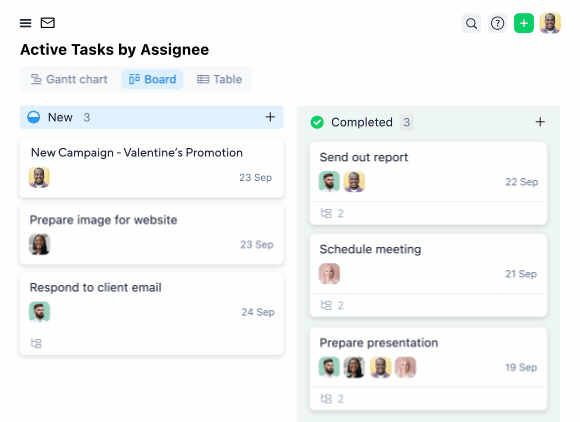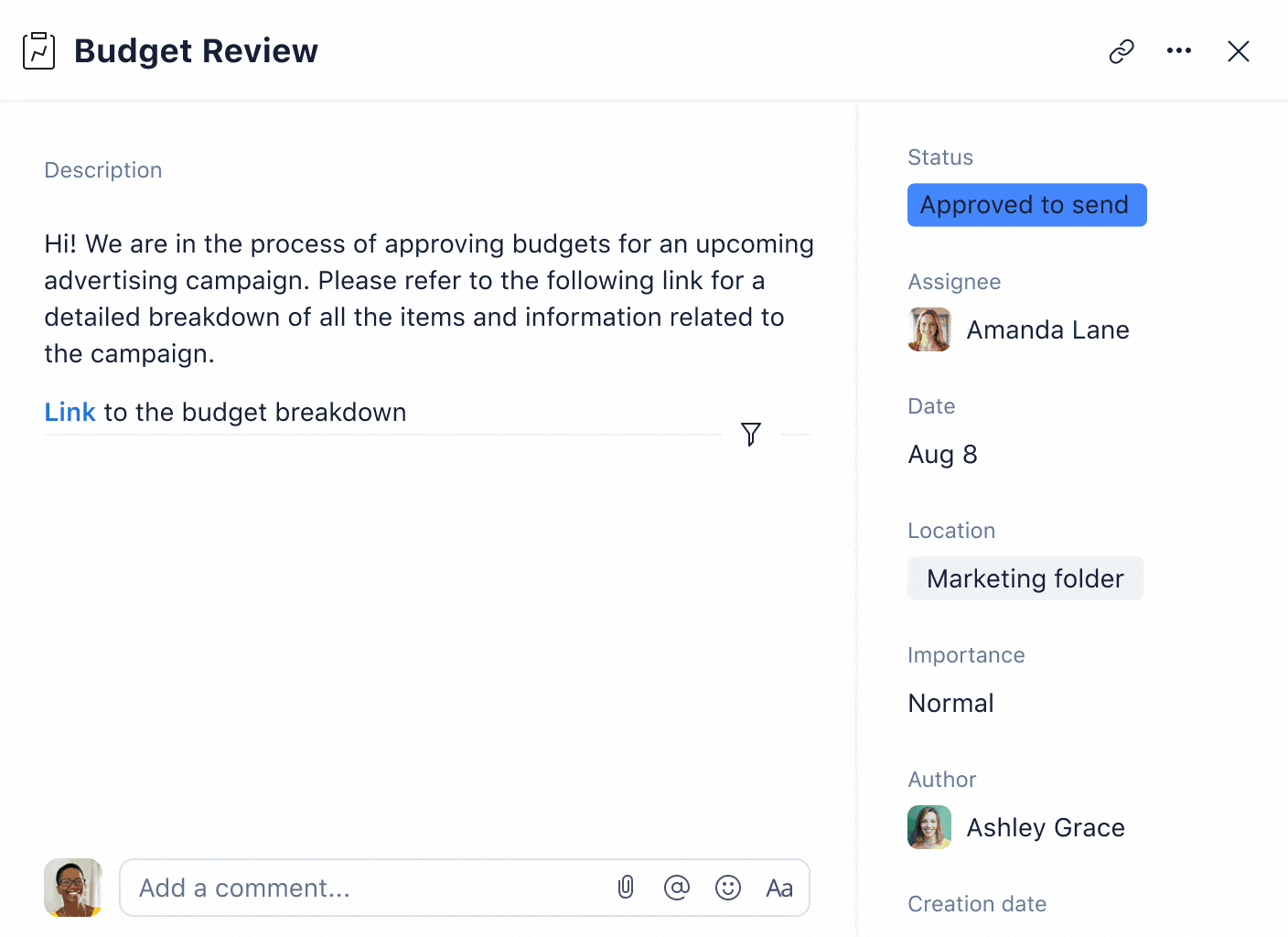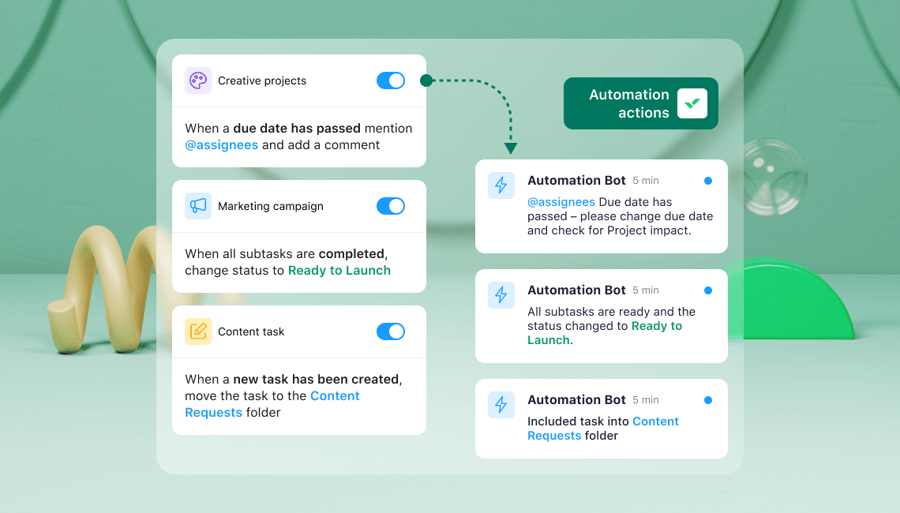Workflow automation software comes into play when:
- Teams are spending too much time on repetitive business processes
- Tasks and workflows are getting lost across multiple tools and apps
- Projects are facing delays and disruption
- Management is looking for opportunities for greater efficiency
Automation tools come to the rescue by taking a lot of the mundane project work out of your hands. The best workflow automation software frees you and your teams to tackle valuable tasks while unifying entire workflows (that would once span potentially hundreds of apps) all in one place.
Lots of articles out there only give you the most basic background information about automation software. This guide is different. We’ll describe some of the most important features of any workflow automation platform (with a focus on our own, Wrike), and tell you about three real-life organizations that have optimized the way they work by using automation.
Wrike is a workflow management tool that’s used by 20,000+ customers in over 140 countries across the world. Book a demo to try it for free.
4 automation features that will optimize your business workflows
We built Wrike to be a complete workflow automation solution — one that’s customizable enough to fit the needs of even the largest, busiest departments and teams. And we’re proud that the likes of Sony Pictures Television, The Estée Lauder Companies, and BigCommerce are among our users.
So, what can a platform like ours actually do to automate your workflow processes? Before we get into some examples of how real organizations are nailing their workflow automation, we want to share four functionalities that you should expect from an enterprise-grade solution.
- Easy rule-based automation of tasks/workflows
- Customizable workflows to suit your organization
- Automated tasks across all your apps and integrations
- Artificial intelligence (AI)
Let’s dive into this functionality in more detail:
1. Easy rule-based automation of tasks and workflows
On a basic level, automation software automates your repetitive tasks to cut the time your teams need to spend on manual processes. Yet with Wrike, it’s not only tasks that you can automate. Instead, you can automate entire project workflows, from start to finish.
Wrike’s automation can handle actions such as:
- Changing the status of tasks in real time (e.g., from “In progress” to “Ready for approval”)
- Assigning tasks and notifying colleagues of deadlines
- Emailing external clients and stakeholders for approval
- Setting up calendar events for scheduled meetings
It’s easy to get started with these automations and there’s no coding required at all. All you need to do is set up rules based on a user-friendly “when/then” structure. For example:
- When the status of a task isn’t updated for a week, then @mention assignees and leave a comment.
- When the status of projects changes to “Completed,” then move the projects to the “Archive” folder.
You can build these automations for your custom workflows from scratch. But to help you get kicked off, we’ve added 50 ready-to-use automation use cases to Wrike already. These templates are organized in categories such as reminders and @mentions, custom fields, assignment and workload, and more. This way, you can discover the benefits of process automation right away.
But you don’t need to limit yourself to automating single tasks. Instead you can set up automations for your entire workflow, with a custom request form. Simply create a form collecting all the information you need to complete a project and Wrike will set up the whole workflow, stringing multiple tasks together automatically.

So, let’s say you’re part of a creative team. Your request form will include everything you need about an asset that needs to be created, such as content, design, proofing, and launch. Wrike then assigns tasks, sets up dependencies, and notifies everyone when their task is ready.
2. Customizable workflows to suit your organization
We built Wrike so it can fit neatly around the specific ways you want to work, whether your team is focused on designing, manufacturing, logistics, HR, legal, or anything else. Importantly, it is specifically designed to enable cross-team collaboration for large, complex organizations.
With Wrike, nobody’s forced to accept a process that doesn’t work for them; your automations can be customized to keep everyone happy. Structure, automation rules, and nomenclature can be adapted to each team. For instance, one department might prefer to receive notifications via email rather than Slack, or use Adobe Creative Cloud rather than Docs. That’s no problem.
You can also set up custom item types that fit your working structure. These are items in your workflow that don’t sit in conventional hierarchies of project, task, or subtask — such as user stories, bugs, or something else entirely.

3. Automated tasks across all your apps and integrations
The reality of modern work is that most organizations are simply using too many tools. From Slack for messaging to Salesforce for your CRM, teams are slowed down by fragmenting workflows across multiple apps and systems.
In these cases, it hardly makes sense if your automations are limited to your project management tool alone. That’s why Wrike lets you automate tasks across your integrations, so that you can streamline your workflows, no matter where you’re working.
Here are three examples of automated workflows that you can create across different apps:
- When a task changes status, then send an email or set up a Google Calendar event.
- When it’s a day before a deadline, then send a Slack message.
- When you complete a project, then create an invoice in QuickBooks.

As a result, Wrike becomes the control center for your work across all your tools. And it’s completely no-code, making your business process management easy without you needing technical skills.
4. AI to identify new opportunities for automation
With lots of task management platforms out there on the market, it’s relatively easy to automate tasks you already know you want to automate. But you’re probably missing great opportunities for automations you weren’t even aware of.
That’s exactly why we built Wrike Work Intelligence®. Wrike’s AI can identify and suggest manual tasks for efficiency gains. These suggestions are based entirely on your teams’ behavior, meaning they’re tailored specifically to your organization.

Ultimately, identifying and setting up your automations shouldn’t be an additional task on your to-do list. Instead, Wrike saves you time, so you can dedicate yourself to more valuable work.
And AI can do a lot more besides. For instance, it can identify the projects that are most likely to face disruption, creating accurate forecasts based on your past workflows. And you can make sure that the most crucial tasks get the resources they need before they go off-track.
3 examples of organizations using workflow automation software
Now we’ve outlined the key functionality of the best workflow automation software, let’s check it out in action. Below are three examples of companies using Wrike to optimize and automate their processes.
1. Moneytree speeds up marketing projects by 75%
Founded in 1983, Moneytree is a retail financial services provider with more than 80 branches across North America.
Before onboarding Wrike, Moneytree’s marketing team had been juggling a combination of email, spreadsheets, and in-person meetings to assign work, track progress, and manage edits and approvals. This caused problems that might be familiar to you, too. Project statuses had to be updated manually, no one could see what anyone else was up to, and work was taking time to get approved.
After considering a variety of different automation software options, Moneytree ultimately chose to use Wrike.
Wrike is so flexible and robust and has just about every feature under the sun. You don’t sacrifice anything. We would have had to work our processes around the other tools. But we could see Wrike would work with our existing processes.
Alex Bacon, Marketing Project Manager
What impact did Wrike have at Moneytree?
- Increased the speed of marketing projects by 75%. Wrike reduced the team’s reliance on email, so projects moved down the pipeline from ideation to approval much more quickly.
- A single, automated source of truth on projects. Rather than Alex having to update statuses across various tools, Wrike did this all for her. In fact, that single automation saved her three hours a week.
- Creating reports became effortless. Wrike’s “Active Task by Assignee” report “is a clean, simple, easy way to see all of the work and set priorities for the week,” says Alex. Wrike’s automated reporting saves her 1.5 hours per week, as she no longer needs to update a spreadsheet or chase team member statuses.
Read the full story: Moneytree Adopts Wrike and Speeds Up Marketing Projects by 75% from Start to Final Approval
2. Syneos Health boosts efficiency across 15,000+ projects
Syneos Health is a fully integrated biopharmaceutical solutions organization, with over 28,000 employees in 110 countries. Just like Moneytree, it was managing a growing workload using processes that were no longer up to the task (mainly involving spreadsheets and email).
“Our reliance on disconnected management systems and manual processes resulted in inefficiencies and redundancies across our workflows. It was time for a change,” Sherrie Besecker, Creative Technology Manager at Syneos Health, explains.

The moment our teams saw Wrike, we heard a resounding ‘yes.’ It was the one system that met each and every one of our team’s comprehensive and complex requirements.
Sherrie Besecker, Creative Technology Manager
Here’s how Wrike’s workflow automation software made an impact for Syneos Health:
- Saved time by replacing spreadsheets with automated dashboards. Syneos Health’s project managers were previously spending hours doing manual data entry in a huge, impractical spreadsheet. “We’ve now cut those hours spent updating down to zero,” says Sherrie.
- Made planning project workflows easy. “Customized workflows and adaptable request forms have enabled us to create new projects in a snap,” Sherrie told us. By simplifying complex workflows, Wrike cut down preparation time from half an hour to just five minutes.
- Customize the entire project structure. “We’ve really been able to customize and create our ideal workplace of the future,” says Sherrie. “Wrike has become the lifeblood of our day-to-day operations.”
Read the full story: Syneos Health Builds a Workplace of the Future With Wrike
3. Electrolux’s design team spends 30% less time per project
As a globally recognizable appliance brand that’s been active for over a century, Electrolux has designed and manufactured over 250 luxury home appliances.
But the global packaging design team at Electrolux needed a better way to manage the process of creating, adjusting, and approving packaging from start to finish. They were juggling multiple sources of information, including emails, PowerPoints, chat functions, meetings, Excel files, and Post-its. But navigating between them was proving to be really time consuming.
Electrolux turned to Wrike as a process automation solution. As a result, it reduced the amount of emails sent by half and now spends 30% less time on each project. They also:
- Reduced delays and confusion via real-time information on projects. “For a person who isn’t good at planning their work, Wrike will help them see what they need to do and when they need to deliver and where they need to find the information,” says Johan Alm, Design Coordinator.
- Automate workflows from scratch. Electrolux set up a custom form and Wrike assigns tasks, sets deadlines, and kicks off the whole project.
- Created space for more valuable work. While Electrolux is taking on the same number of projects, it’s able to do more in each project. For example, now it’s able to complete 40 artworks in each project, rather than four.
3 other workflow automation software tools to consider
While we’ve built Wrike to be truly customizable, it might not be the perfect fit for every organization (especially small companies, who need something more basic). To help you make the right choice, here are some of the most widely known workflow automation tools out there right now.
1. Kissflow: Workflow automation for beginners and small businesses
Kissflow is an automation software that’s built to be simple.
It’s entirely no-code, meaning that you don’t need any technical teams to set up your automations. Instead, it works using a drag-and-drop interface, which helps you get started quickly. Plus, it has a range of templates and 50 in-built app integrations.
That’s why it’s a good choice for small businesses that are just starting out in workflow automation. While some reviewers note that it comes with a bit of a learning curve (particularly if you’re not used to working with automations at all), it has most of what you need to get moving.
The question is how well it operates at scale. One reviewer points out that it lacks advanced features, while another suggests that, in terms of pricing, it’s not convenient for larger organizations.
2. HubSpot: Workflow automation and CRM
HubSpot is a widely used business tool. However, it’s less known for its automations than for its CRM functionality, including its features for sales and marketing teams.
This means that HubSpot is only really worth your time if you want a platform that combines all this functionality. If you already have a CRM, for instance, or you want to automate processes that aren’t related to these fields, it won’t make a lot of sense.
That said, HubSpot’s workflow automations are simple to set up without code. You can also create custom connections with different apps through Hubspot’s coding language, HubL.
For instance, in HubSpot, you can automate follow-ups with leads who interact with your content. If they complete a sign-up form, then their details will be automatically added to an email list. Or you can create an automation to assign leads to a sales team.
3. Zapier: Workflow automation software to connect your existing apps
Zapier isn’t so much a tool that allows you to manage your workflows and projects — it’s more of a software where you can set up automations between different tools. The automations that Zapier facilitates work really well. As just one small example, if someone completes a task, you can tell Zapier to message a channel in Slack and update a shared Google Sheet.
If you’re already using multiple apps and don’t need a central hub to manage them better, Zapier makes sense. But if you need additional project coordination features, it’s better to opt for Wrike. (Note: we also offer a Zapier integration, meaning you can use Zapier to hook Wrike up to any other app that supports it — so you’re covered, even if Wrike’s 400+ integrations don’t include the tool you need.)
Join 20,000+ organizations who use Wrike for workflow automation software
In this article, we’ve shared the stories of three organizations that use Wrike as a workflow automation software, alongside the automation features they commonly use.
If you’re looking for a software platform that provides a single source of truth for your work — while automating key business processes — look no further. Book a demo today and try it out for yourself.







